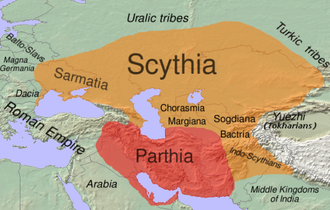Pan-Islamic-Pakistan
ELITE MEMBER

- Joined
- May 28, 2018
- Messages
- 13,150
- Reaction score
- 5
- Country
- Location
This series, 'Historical Background of Pakistan and its People', is written by Ahmed Abdulla and edited by K. Hasan.
----
PART-1 can be found here: Historical Background of Pakistan and its People/Rarely part of India/IVC
PART-2: Coming of the Aryans/ Persian Rule
PART-3: Alexander the Great/ Mauryans/ Graeco-Bactrians
----
PART-4
THE SAKAS
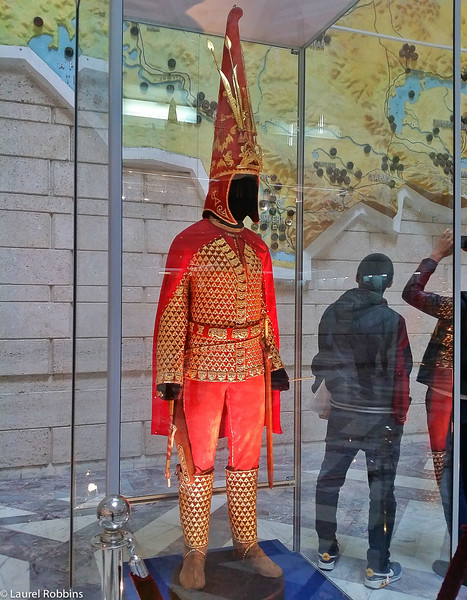
The Graeco-Bactrian rule, like that of its predecessor the Mauryan, did not last for more than a century. Internecine warfare and internal schisms soon weakened them. Pakistan was divided into several petty Greek Kingdoms which easily fell victim to the great wave of Scythians (Sakas) which took place in the middle of the first century B.C. This was a huge sea of nomads which, pressed in Central Asia and on China's borders by fiercer and tougher people migrated on an extensive scale. They overthrew the Greek rulers and established their sovereignty as well as settlements all over Pakistan.
Pakistan began to receive many waves of Sakas and Parthians. In the next stage beginning from 1st century B.C. wave after wave of the people such as the Kushans, the White Huns and the Gujjars also began to settle in Pakistan. In the course of time, all of these groups constituted an overwhelmingly predominant element of its population. This composition continues to this day. These waves were so large and cataclysmic that everything was sub-merged in it or absorbed by it. The waves of Sakas were so enormous and their settlements so vast that Pakistan came to be known to Greek geographers as Scythia and in Indian literature as Saka-dipa.
The first three Saka kings of Pakistan were Maues, Azes I and Azilises. Their numerous coinages are, almost without exception, copied from those of their Yavana (Greek) predecessors. As regards language and culture, the Sakas mostly adopted those of the Pahlavas or Parthians of Iran. In fact at a later stage Saka-dipa (Pakistan) was ruled by Pahlava princes. The most well-known of them was Gondopharnes whose capital was Taxila. During his reign (20-48 A.D.) St. Thomas, according to early ecclesiastical legends, preached Christianity in his dominions.

"Of the political history of this period a great deal is still in suspense. The leaders of the Sakas in the Indus basin seem to have first acknowledged the power of the local Greek Indian rulers. It is not until a few decades later that they felt themselves strong enough to lay claim to supreme suzerainship. Ghandara became the centre of the Saka domains, and the eastern Capital city of Taxila was chosen by the Saka king Mavak (Maues or Mauakes in the ancient authors, and Moga in early Indian sources) in the middle of the first century B.C. as its residence. Mavak's successors propagated their power over a considerable part of the Punjab.
"In the north-west in the Punjab, however, the Saka leaders' hold was shortlived. The dynasty founded by Mavak was overthrown by the Parthians as early as the beginning of the first century of our era.
"In the Western Punjab, Upper Sind and Derajat, a number of warring rulers related to the Surens, a Parthian clan controlling the eastern areas of Iran, held sway. The Parthian Kings, who keep ousting one another, rule over this country" (The Peoples of Pakistan, By Yu.V.Gankovsky).
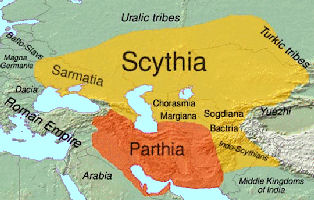
SAKA ORIGIN
The Scythians inhabiting Central Asia at the time of Herodotus (5th century B.C.) consisted of 4 main branches known as the MassaGatae, Sacae, Alani, and Sarmatians, sharing a common language, ethnicity and culture. Ancient Greek (e.g. Herodotus, Pliny, Plotemy, Arrian) and Persian sources (Darius's historians) from the 5th century place the MassaGatea as the most southerly group in the Central Asian steppe. The earliest Scythians who entered the northern regions of South Asia were from this group.
Historians derive "Jat" from "Gatae", "Ahir" from "Avar", "Saka" from "Scythii", "Gujjar" from "Khazar", "Thakur" from "Tukharian", "Saurashtra" from "Saura Matii" or "Sarmatians", "Sessodia" (a Rajput clan) from "Sassanian", "Madra" from "Medes", "Trigartta" from "Tyri Getae" and "Sulika" from "Seleucids". "Massa" means "grand" or "big" in old Iranian - the language of the Scythians.
The early Sakas or Scythians are remembered by Greek (e.g. Herodotus, Megatheses, Pliny, Ptolemy) and Persian historians of antiquity as tall, large framed and fierce warriors who were unrivalled on the horse. Herodotus from the 5th century BC writes in an eye-witness account of the Scythians: "they were the most manly and law-abiding of the Thracian tribes. If they could combine under one ruler, they would
be the most powerful nation on earth." According to their origin myth recorded by Herodotus, the Sakas arose when three things fell from the sky: the i) plough, ii) sword and iii) cup. The progenitor of the Sakas picked them up and hence the Saka race began its long history of conquering lands, releasing its bounties and enjoying the fruits of their labor (the cup has a ceremonial-spiritual-festive symbolism). The relevance of these symbols and codes of life and culture to the traditional Punjabi and northwest society are tantalizingly obvious. A branch of the Sakas kown as the Alani reached regions of Europe, Asia Minor and the Middle East. They have been connected to the Goths of France/Spain, Saxons and the Juts of Denmark.
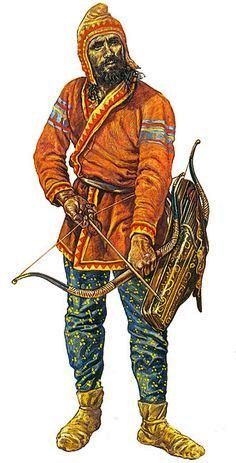
Entry into Southasia
Some of these Saka tribes entered northwest Southasia through the Khyber pass, others through the more southerly Bolan pass which opens into Dera Ismail Khan in Sindh. From here some invading groups went north, others went south, and others further east. This explains why some Jat, Gujjar and Rajput clans claim descent from Rajasthan (Chauhan, Powar, Rathi, Sial etc.) while others from Afghanistan (e.g. Mann, Her, Bhullar, Gill, Bajwa, Sandhu, etc.). This is supported by the fact that the oldest Rajput geneologies (10th centuries) do not extend into the northwest's Gandharan Buddhist period (400 B.C. - 900 AD).
Sir Cunningham (former Director General of Indian Archeological survey) writes:
"the different races of the Scythians which succesively appeared as conquerors in the
border provinces of Persian and India are the following in the order of arrival: Sakas or Sacae (the Su or Sai of the Chinese - B.C. ?), Kushans (the great Yue-Chi (Yuti) of the Chinese - B.C. 163), Kiddarite or later Kushans (the little Yue-chi of the Chinese -A.D. 450) and Epthalites or White Huns (the Yetha of the Chinese - 470 A.D.).
Cunningham further notes that
". . . the successive Scythian invasions of the Sakas, the Kushans, and the White Huns,
were followed by permanent settlements of large bodies of their countrymen . . ".
Cunningham and Tod regard the Huns to be the last Scythian wave to have entered India.
Herodotus reveals that the Scythians as far back as the 5th century B.C. had political control over Central Asia and the northern subcontinent up to the river Ganges. Later Indo-Scythic clans and dynasties (e.g. Mauryas, Rajputs) extended their control to other tracts of the northern subcontinent.
According to Ethnographers and historians like Cunningham, Todd, Ibbetson, Elliot, Ephilstone, Dahiya, Dhillon, Banerjea, etc., the agrarian and artisan communities (e.g. Jats, Gujars, Ahirs, Rajputs, Lohars, Tarkhans etc.) of the entire west are derived from the war-like Scythians who settled north-western and western South Asia in successive waves between 500 B.C. to 500 AD. Down to this day, the very name of the region `Gujarat' is derived from the name `Khazar', whilst `Saurashtra' denotes `Sun-worshipper', a common term for the Scythians. The northwest Southasian region continues to be the most Scythic region in the world.
The oldest Rajputs clans arose much later from earlier Scythic groups; or are of Hun origin (5-6th century AD); and many are no doubt of mixed Scythic-Hun origin. Virtually all are of Scythic descent.
----------------------------
The Sakas - Indo-Scythians
Jason Neelis
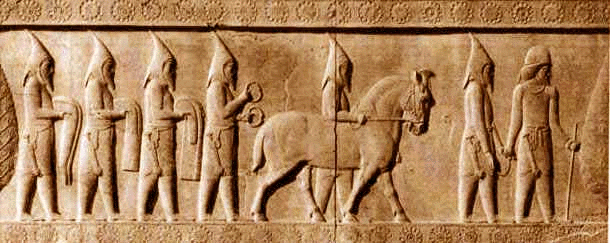
Saka nomads from Central Asia migrated to the northwest of South
Asian subcontinent in the first and second centuries BCE. Herodotus
(4.1-142) describes the extent, customs, and origins of various
groups of Scythians (designation for Sakas in Western classical
sources) who inhabited large areas of the steppes of Central Asia on
the northern peripheries of the Greek world. The Sakas are also
known from Old Persian inscriptions of the Achaemenid Empire. The
Naqs-i-Rustam inscription of Darius I distinguishes three groups of
Sakas:
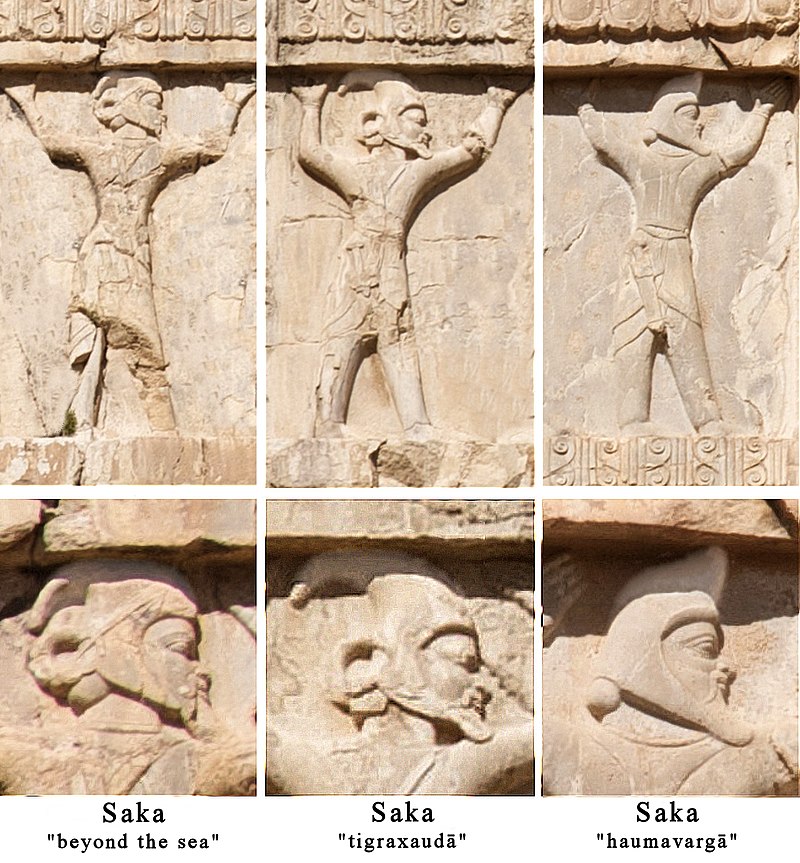
1) Saka Tigraxauda: "Sakas wearing the pointed cap" who are
portrayed in a sculpture at Behistun and described by Herodotus
(7.64) as "clad in trousers" and having "on their heads tall stiff
caps rising to a point"; these Sakas lived between the Caspian Sea
and the Jaxartes River (Syr Daria);
2) Saka Haumavarga: "hauma-drinking" or "hauma-preparing" Sakas
(hauma is a type of alcoholic beverage) identified with the Amyrgian
Scythians of Greek sources, possibly located in the southeastern
Iranian province of Drangiana, which later became known as Sakastan
or Seistan;
3) Saka Paradraya: Sakas "across the sea" who probably lived north
of the Black Sea and in the Russian steppes, although some groups
reached the Danube Valley in central Europe, Syria, and upper
Mesopotamia.
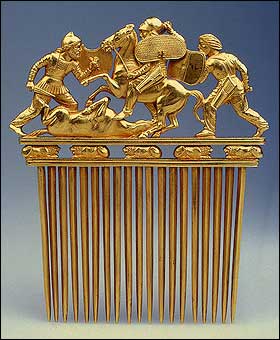
Chinese historical annals refer to the movements of the Sai (Chinese
designation for Sakas) southwards into northwest of South Asia
following a period of disturbances in Central Asia during the second
century BCE. According to the History of the Former Han (Han shu),
covering the period from 206 BCE to 25 CE: "When, formerly, the
Hsiung-nu [Xiongnu] conquered the Yueh-chih [Yuezhi] the latter
moved west and established themselves as masters of Ta Hsia [Da
xia]; it was in these circumstances that the king of the Sai moved
south and established himself as master of Chi-pin [Jibin]. The Sai
tribes split and separated and repeatedly formed several states."1
The westward migrations of the Yuezhi (see Kushan essay) led to the
emigration of the Sai sometime before 128 BCE, when the Han
ambassador Zhang Qian arrived in Sogdia and Bactria to make an
alliance with the Yuezhi. Saka migrations were not led by a single
king, but were probably gradual movements of acephalous groups to
Jibin, a region apparently corresponding to Gandhara or to northwest
of South Asia in general.
At the beginning of the first century BCE, two or possibly three
groups of Sakas migrated to South Asia from Central Asia:
a) Sakas from the north (perhaps coming from Khotan) took the 'Pamir
routes' through the Karakorum Mountains to Swat and Gandhara;
b) Sakas crossed the Hindu Kush under pressure from the Yuezhi to
mountain valleys of northeastern Afghanistan;
c) Sakas coming from the southwest (Sakastan) took control of modern
Sindh in southern Pakistan.
Maues was one of the earliest Indo-Scythian rulers during the early
first century BCE. His name is preserved in bilingual Greek (Maues)
and Kharosthi (Moa) coins and a Kharosthi inscription from Taxila
(Moga). Maues' origins are obscure: he may have been connected with
the Sakas of Sakastan, or he could have belonged to another branch
of Sakas that migrated from the north through the mountains to
Gandhara and Taxila. In giving himself the title of "King of Kings"
in bilingual Greek and Kharosthi coin legends, Maues imitated
Parthian royal titles. A Kharosthi inscription on a copper plate
from Taxila dated in year 78 of an unspecified era during the reign
of "maharaja Moga the Great" records the establishment of Buddhist
relics by a donor named Patika, the son of an official (ksatrapa)
named Liaka Kusulaka. The inscription demonstrates that Liaka
Kusulaka acknowledged the authority of Maues as his overlord.
Decentralized administration continued after the period of Maues
under loosely affiliated officials who acknowledged a more powerful
leader.
Numismatic sequences and inscriptions show that Azes followed Maues
as the most powerful Indo-Scythian ruler in 58 BCE, a date
corresponding to the beginning of the so-called "Vikrama" era, which
is still used in India. Like his predecessor, Azes adopted the title
of "King of Kings" and iconography of Greek and Indic gods and
goddesses from the coins of contemporary Indo-Greeks. Indo-Greek
power in territories of central Afghanistan and eastern Punjab
rapidly diminished during the second half of the first century BCE
as Indo-Scythians predominated. Azes and his successors Azilises and
Azes II administered Taxila and other areas of Pakistan and
northwestern India through regional rulers with Iranian, Greek, and
Indian titles.
Another branch of Indo-Scythians called the "Western Ksatrapas"
ruled parts of western India from the first century BCE to the end
of the fourth century CE. The Western Ksatrapas vied with the
Satavahanas, another regional dynasty in western India, to control
trade routes between the Deccan Plateau and ports on the west coast.
This area flourished due to lucrative long-distance trade across the
Indian Ocean to the Red Sea and Mediterranean (described in the
Periplus Maris Erythraei). The Western Ksatrapas and other ruling
families and groups of merchants supported Buddhist cave monasteries
clustered along routes through the Western Ghats (see essay on
Buddhism and Trade). Ujjayini in central India was the center of the
Western Ksatrapas from the second to early fourth centuries, until
the Gupta ruler Candragupta II defeated the "Sakas" between ca. 395-
400 CE.
Sakas in control of major commercial centers along the "Northern
Route" (Uttarapatha) and "Southern Route" (Dakshinapatha) encouraged
the development of trade networks and supported religious
institutions. Inscriptions that record the establishment of Buddhist
relics and donations to monasteries in Gandhara, Taxila, Mathura,
and western South Asia show that Sakas, Parthians, and other
Iranians were active lay supporters of the Buddhist community. Saka
support of Buddhism did not preclude their patronage of other
religious traditions or imply that their old beliefs were abandoned.
Iranian elements in architecture, iconography, languages, and many
other spheres of South Asian life around the beginning of the Common
Era are easy to recognize. Concurrent with their impact in South
Asia, migrations of the Sakas during the last two centuries BCE and
the Kushans in first century CE from Central Asia to northwest of
South Asia eventually led to the transmission of Buddhism in the
other direction to Central Asia and East Asia.
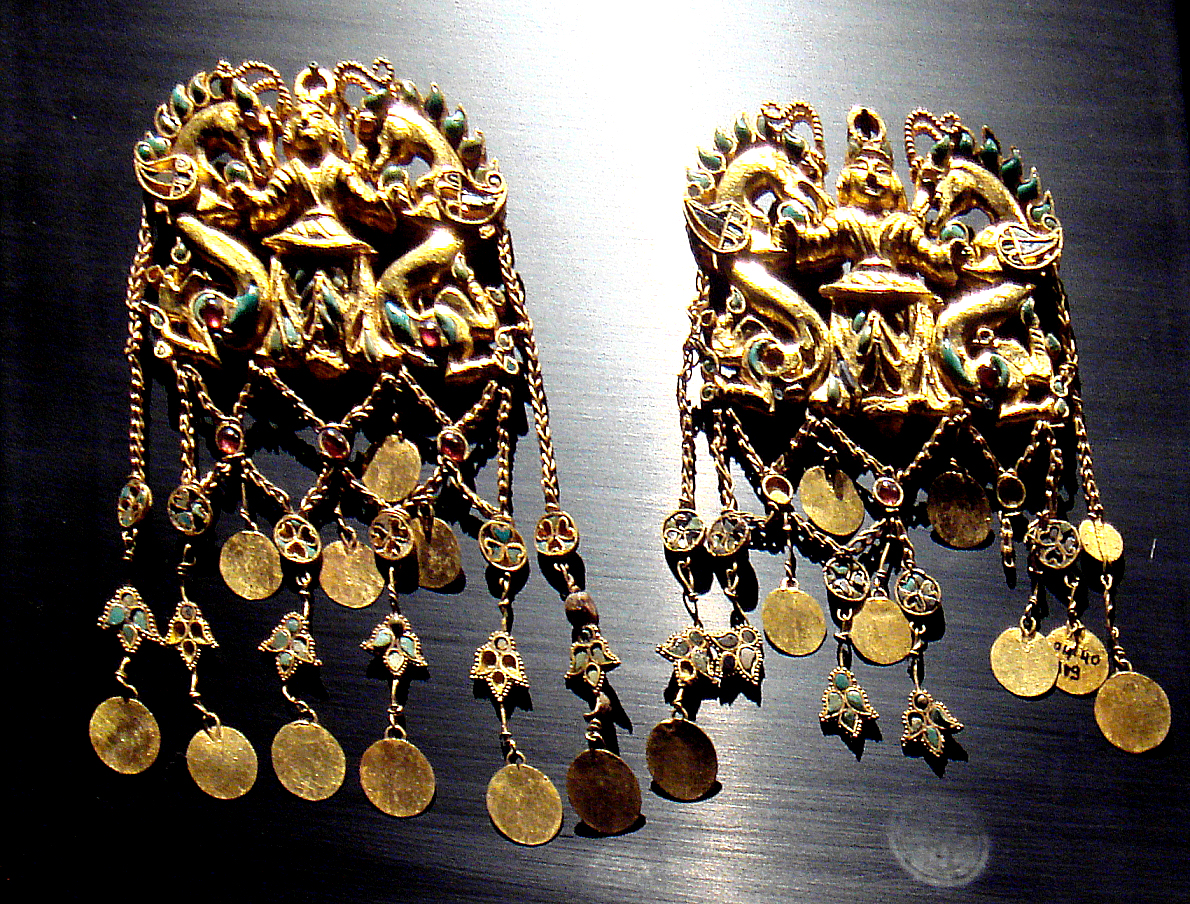
(1) Translation of Anthony F.P. Hulsewe in China in Central Asia.
The Early Stage: 125 B.C. - A.D. 23 (An Annotated Translation of
Chapters 61 and 96 of the History of the Former Han Dynasty).
Leiden: E.J. Brill, 1979, pp. 104-5. Pinyin equivalents in brackets
correspond to the Wade-Giles transliterations.
-----
THE KUSHANS
The next important chapter in Pakistan's history begins with the arrival of another wave of Central Asian tribes called the Yueh-chi. Because of the turbulent and unsettled conditions on the borders of China, one tribe was chasing out the other and occupying their grazing lands. One such movement brought the Yueh-chi to Pakistan, a branch of which was known as the Kushans. This was about the middle of the first century A.D.
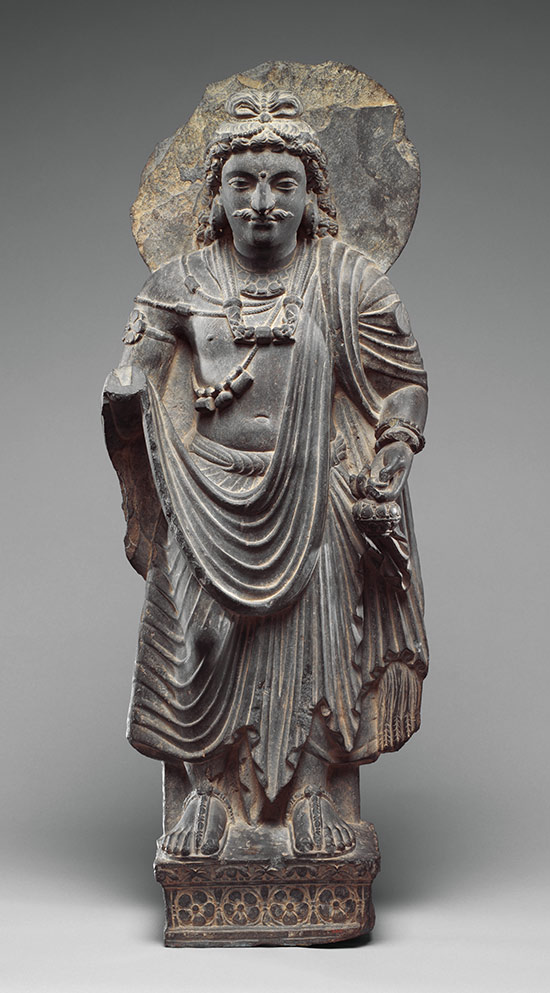
The Kushans overthrew the Saka-Parthian princes and established an empire which became one of the world's greatest and most distinguished both from the point of view of territory as well as cultural and religious achievements. The Kushan ruler who Conquered Pakistan was Vima Kadphises who was succeeded in about 78 A.D. by Kanishka. The Kushan rule, however, did not completely eliminate the Sakas from Pakistan. They had permanently settled down in these areas in large numbers and continued to be governed by their princes who merely extended allegiance to the Kushan kings.This is proved by the Sue Vihara inscription in the Bahawalpur Division which is dated in the regnal year of Kanishka 11(89 A.D.). Even the era said to have been founded by Kanishka in 78 A.D. was known as Saka Era. "There is evidence to show that they (Sakas) still governed their own states, no doubt as feudatories more or less nominal of the Kushans" (Cambridge History of India, Vol.1, edited by E.J. Rapson).
The Kushans, with their capital at Purushapura (Peshawar) had their dominions on both sides of the Hindu Kush i.e., extending up to and including parts of Turkistan in the north-west, embracing the whole of modern Afghanistan, and in the east the entire Pakistan and major portion of northern India. The greatest ruler of the dynasty, Kanishka, had adopted Buddhism and it was during his period that both Buddhist religion and Greek art reached their zenith which is known under the nomenclature of Gandhara Civilization. It was again during his regime and because of his efforts that Buddhism spread in Central Asia and China. This period is regarded as the most important in the history of Buddhism.
The budding and blossoming of Gandhara art was not a new phenomena in Pakistan's history as this land had given birth to several such brilliant civilizations since pre-historic times beginning with Indus Valley Civilizadon. Judeiro Daro and Shahi Tump in Baluchistan; Moenjo Daro, Kot Diji, Amri, Chanhu Daro, and Sehwan in Sind; Harappa, Sari Kola and Taxila in the Punjab, Takht-i-Bahi and Mingora in NWFP have been seats of learning and art, centres of great religious activity and pivots of political power. It may be pointed out that Sari Kola in Pindi Division (3000 B.C.), Kot Diji in Khairpur Division (2800 B.C.) and Amri in Dadu District (3000 B.C.) are all pre-Indus Valley civilizations.
"When the great monarch Kanishka actively espoused the cause of Buddhism and essayed to play the part of a second Ashoka, the devotion of the adherents of the favoured creed received an impulse which speedily resulted in the copious production of artistic creations of no small merit.

"In literature the memory of Kanishka is associated with the names of the eminent Buddhist writers Nagarjuna, Asvaghosha and Vasumitra. Asvaghosha is described as having been a poet, musician, scholar, religious controversialist and zealous Buddhist monk. Charaka, the most celebrated of the early Indian authors treating of medical science, is reputed to have been the court physician of Kanishka.
"Architecture, with its subsidiary art of sculpture, enjoyed the liberal patronage of Kanishka, who was like Ashoka a great builder. The tower at Peshawar built over the relics of Buddha and chiefly constructed of timber stood 400 feet high. The Sirsukh section of Taxila hides the ruins of the city built by Kanishka. A town in Kashmir, still represented by a village bore the King's name" (Oxford History of India, by V.A. Smith).
A unique feature of Kanishka's empire was that with the capital at Peshawar its frontiers touched the borders of all the great civilizations of the time, while its Central Asian provinces lay astride the Roman Middle East-Chinese trade routes. Roman Empire during the days of Trajan and Hadrian (98-138 A.D.) had expanded furthest East almost touching Pakistan's Kushan Empire. Similarly, Kanishka's conquests had brought Khotan,Yarkand and Kashgar within Pakistan's jurisdiction effecting direct contact with China. This was one of the most important factors in providing impetus to art and architecture, science and learning in Pakistan. The best specimen of Graeco-Roman art discovered in and around Peshawar, Swat and Taxila belong to this period, mostly executed during the 2nd century A.D. in the reigns of Kanishka and his son Huvishka. The Kushans exchanged embassies with the Chinese as well as the Romans. Mark Antony had sent ambassadors, and the Kushans sent a return embassy to the court of Augustus "In the middle of the first century of our era, one of the Tokhari princes belonging to the Kushans, Kujula Kadphises, unified the dispersed Tokhari principalities. As he grew stronger, the leader of the Kushans extended his suzerainship to the lands south of the Hindu Kush, in the Kabul Basin and on the Upper Indus. Kujula Kadphises's successors, the most prominent of whom was Kanishka (circa A.D. 78-120) kept on the expansive policy of his subcontinent (Kashmir, the Punjab and Sind). The rulers of Gujrat, Rajasthan and the states lying in the Ganges-Jumna doab were the vassals of the Kushan kings. The Kushan kings also held control of the territory of the present day Afghanistan, Kashgar, Khotan, Yarkand and the southern areas of Middle Asia. Gandhara i.e., the territory lying in the valleys of the Kabul and the Middle Indus, became the centre of a vast empire. The city of Purushapura (the present-day Peshawar) is known to have been the capital of Kanishka.

"The Kushan empire dissolved in the third century of our era. The Iranian shahs of the Sassanid dynasty took in the western territories. Various dynasties of Middle Asia took hold of the lands north of the Hindu Kush" (The Peoples of Pakistan, By Yu.V.Gankovsky).
After ruling for over two hundred years from the middle of the 1st century A.D. to the middle of the 3rd century A.D. the Kushan Empire collapsed. Already, a few decades earlier, its frontiers had shrinked to those of Pakistan having shed the territories beyond Hindu Kush in Central Asia and eastward of Sutlej in India. The final blow was administered by Shahpur I, the head of a new dynasty of Sassanians that had emerged in Iran in 226 A.D. after a long period of anarchy prevailing for over 500 years since Alexander had eliminated the Achaemenians. "Shahpur I clearly includes in his Empire the greater part of Pakistan. Shahpur's son Narses had been made Shah of Seistan, Baluchistan and Sind and the seashore i.e., Pakistan and a bit more" (Pakistan in early Sassanian times, By M. Sprengling).
But this time Iran could not keep its sway over Pakistan for long. Though defeated, Kushans continued to rule over Pakistan for a considerably long period with the smaller kingdoms still retained by the redoubtable Sakas---both being Central Asian tribes. It seemed that ethnically and politically the Central Asian elements had become a permanent feature of Pakistan. Strong Kushan-Saka dynasties continued to exist in Kabul and Pakistan until another great event in the history of this area i.e., the Hun invasions in the 5th century A.D.-----some principalities survived even till the Arab conquest.
An important development had taken place in the neighbouring Country of India a little earlier which deserves our attention. Buddhism, which was on the decline from the 3rd century A.D. onward was overthrown by Hinduism reasserting its lost hegemony. This process culminated with the coming into power of the Guptas by the end of the 4th century A.D. A point of considerable significance to be noted here is that though the Gupta Empire is considered one of the most glorious in the annals of Hindu history covering a vast area of this sub-continent, yet it could not bring Pakistan under its tutelage. During the Gupta period, Pakistan was in the hands of Kushan Shahis and Sassanians. Even during Samudragupta's triumphal career this region remained independent of India. "Samudragupta did not attempt to carry his arms across the Sutlej or to dispute the authority of the Kushan kings who continued to rule in and beyond the Indus basin...... Gupta Empire---the greatest in India since the days of Ashoka-extended in the north to the base of the mountains, but did not include Kashmir" (Oxford History of India).
----
WHITE HUNS (Hephthalites)
Coming back to the Hun invasion it may be mentioned that this was also, like that of the Sakas, one of the greatest migrations of Central Asian nomadic tribes in the history of Pakistan and the sub-continent. The particular branch of the Huns which was encamped in the Oxus Valley and which came to Pakistan was known as Epthalite or White Huns. They were accompanied by a number of other tribes including Gurjaras. They started coming in wave after wave from the middle of the 5th century A.D. and very soon became rulers of Pakistan. One of their mighty rulers was Mehar Gul (Sunflower) whose capital was Sakala, Sialkot.
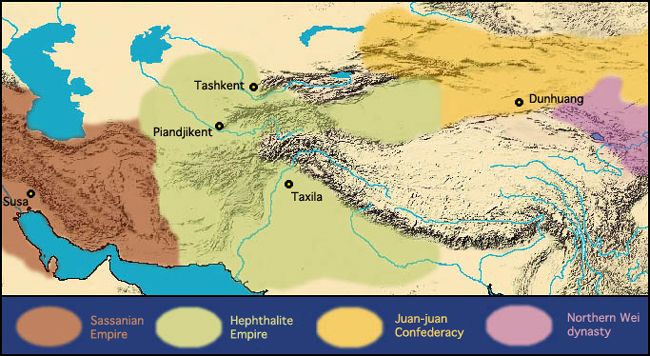
The mass immigration of Huns and Gurjaras extending over the 5th and the 6th centuries constitutes a turning point in the history of Pakistan and of northern India both politically and socially. Politically because henceforth, till the arrival of Muslims, they were the ruling class in Pakistan and in most of northern India. Socially because the origin of majority of the tribes of Pakistan and those of Rajputana is traceable to them. "No authentic family or class traditions go back beyond the Hun invasion. All genuine tradition of the earlier dynasties has been absolutely lost. The history of the Mauryas, Kushans and Guptas, so far as it is known has been recovered labourously by the researches of scholars, without material help from living tradition." (Ibid). Many of Afghan-Pathan tribes and most of the Rajput and Jat clans of the Punjab and Sind are, according to modern scholars, descended from the Epthalites i.e., White Huns.
There was a period of confusion forming the transition from one age to another. Pakistan and north India had left the Early Period of history and entered what is generally termed as the Medieval Period. During the transition the hordes of foreign invaders were gradually absorbed into the Hindu body politic and new grouping of states began to evolve. This period was marked by the development of the Rajput clans never heard of in earlier times. They began to play highly prominent role after the death of Harsha so much so that the 500-year period from the 7th century A.D. to the 12th century A.D. (i.e., till the arrival of Muslim Turks) may be called the Rajput period.
The Hun invasions and their consequences broke the chain of historical tradition. Living clan traditions rarely if ever go back beyond the 8th century and few go as far. The existing clan-castes only began to be formed in the 6th century. The Brahmans found their advantage in treating new aristocracy, whatever its social origin, as representing the ancient Kshatriya class of the scriptures, and the novel term Raja-putra or Rajput, meaning king's son, or member of a ruling family or clan came in use as an equivalent of Kshatriya." (Oxford History of India).
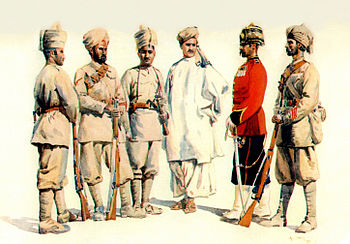
During this 500-year period, again, Pakistan was under quite independent Rajput kingdoms separate from those of India. Even the Gurjara-Pratihara Empire of northern India which was one of the most important formed during this period did not include Pakistan, not even during the days of its greatest and most powerful king Raja Bhoja. "The rule of the Pratiharas had never extended across the Sutlej, and the history of the Punjab between the 7th and 10th centuries A.D. is extremely obscure." (Ibid). At some time during this period, a powerful kingdom had been formed in Pakistan which extended from the mountains beyond the Indus, eastwards as far as the Hakra or 'lost river' in East Punjab so that it comprised a large part of the NWFP and the Punjab. At the time Mahmud Ghaznavi came into power at the end of the 10th century A.D. this kingdom was still in existence and it was with its ruler Raja Jaipal that he came into clash.
White Huns - Hephthalites
Silk Road Foundation
The Origin of Hephthalites
The paucity of record in Hephthalites or Ephthalites provides us fragmentary picture of their civilization and empire. Their background is uncertain. They probably stemmed from a combination of the Tarim basin peoples and the Yueh-chih. There is a striking resemblance in the deformed heads of the early Yueh-chih and Hephthalite kings on their coinage. According to Procopius's History of the Wars, written in the mid 6th century - the Hephthalites

"are of the stock of the Huns in fact as well as in name: however they do not mingle with any of the Huns known to us. They are the only ones among the Huns who have white bodies...."
Ephthalites was the name given by Byzantine historians and Hayathelaites by the Persian historian Mirkhond, and sometimes Ye-tai or Hua by Chinese historians. They are also known as the White Huns, different from the Hun who led by Attila invading the Roman Empire. They are described as a kindred steppe people originally occupied the pasture-lands in the Altai mountain of southwestern Mongolia.
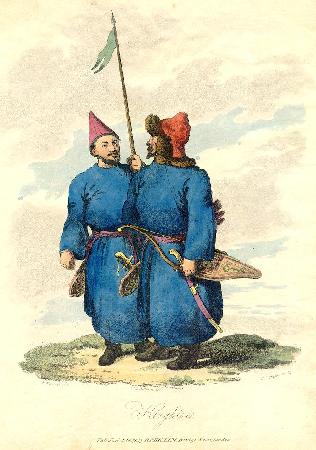
Toward the middle of the 5th century, they expanded westward probably because of the pressure from the Juan-juan, a powerful nomadic tribe in Mongolia. Within decades, they became a great power in the Oxus basin and the most serious enemy of the Persian empire.
The Westward Expansion and War with Sassanian Empire
At the time when the Hephthalites gained power, Kushan and Gandhara were ruled by the Kidarites, a local dynisty of Hun or Chionites tribe. The Hephthalites entered Kabul and overthrew Kushan. The last Kidarites fled to Gandhara and settled at Peshawar. Around 440 the Hephthalites further took Sogdian (Samarkand) and then Balkh and Bactria.
The Hephthalites moved closer and closer toward Persian territory. In 484 the Hephthalite chief Akhshunwar led his army attacked the Sassanian King Peroz (459-484) and the king was defeated and killed in Khurasan. After the victory, the Hephthalite empire extended to Merv and Herat, which had been the regions of the Sassanid Empire. The Hephthalites, at the time, became the superpower of the Middle Asia. They not only destroyed part of Sassanian Empire in Iran but also intervened in their dynastic struggles when the Sassanid royal, Kavad (488-496), was fighting for the throne with Balash, brother of Peroz. Kavad married the niece of the Hephthalites chief and the Hephthalites aided him to regain his crown in 498.

After conquest of Sogdia and Kushan, the Hephthalites founded the capital, Piandjikent, 65 kilometers south-west of Samarkand in the Zaravshan valley. This city later reached its prosperity, produced one of the best mural paintings in the seventh century and later was destroyed by the Arabs. The Hephthalites chose Badakshan as their summer residence. Their chiefs lived north of the Hindu Kush, migrating seasonlly from Bactria where they spent the winter, to Badakshan, their summer residence. Under the Hephthalite control, the Bactrian script and language continued to be used and trade and commerce flourished as previously.
The Eastward Expansion to the Tarim Basin
With the stabilization at the western border, the Hephthalites extended their influence to the northwest into the Tarim Basin. From 493 to 556 A.D., they invaded Khotan, Kashgar, Kocho, and Karashahr. The relationship with Juan-juan and China were tightened. The Chinese record indicated that between 507 and 531, the Hephthalites sent thirteen embassies to Northern Wei (439-534) by the king named Ye-dai-yi-li-tuo.
Invasion to India
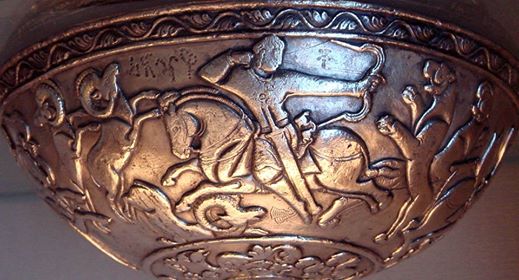
During the 5th century, the Gupta dynasty in India reigned in the Ganges basin with the Kushan empire occupied the area along the Indus. India knew the Hephthalite as Huna by the Sanskrit name. The Hephthaltes or Hunas waited till 470 right after the death of Gupta ruler, Skandagupta (455-470), and entered the Inda from the Kabul valley after the conquest of Kushan. They mopped on along the Ganges and ruined every city and town. The noble capital, Pataliputra, was reduced in population to a village. They persecuted Buddhists and burned all the monasteries. Their conquest was accomplished with extreme ferocity and the Gupta regime (414-470) was completely extinguished.
For thirty years the northwestern India was ruled by Hephthalite kings. We learned some of the Hephthalite kings ruling India from coins. The most famous ones were Toramana and Mihrakula ruling India in the first half of the 6th century.
The Language
There are numerous debates about Hephthalite language. Most scholars believe it is Iranian for the Pei Shih states that the language of the Hephthalites differs from those of the Juan-juan (Mongoloid) and of the "various Hu" (Turkic); however there are some think the Hephthalites spoke Mongol tongues like the Hsien-pi (3rd century) and the Juan-juan (5th century) and the Avars (6th-9th century). According to the Buddhist pilgrims Sung Yun and Hui Sheng, who visited them in 520, they had no script, and the Liang shu specifically states that they have no letters but use tally sticks. At the same time there is numismatic and epigraphic evidence to show that a debased form of the Greek alphabet was used by the Hephthalites. Since the Kushan was conquested by Hephthalites, it is possible they retained many aspects of Kushan culture, including the adoption of the Greek alphabet.
The Religion
It is equally inconsistent while comparing the references to the Hephthalites' religion. Although Sung Yun and Hui Sheng reported that the Hephthalites did not believe in Buddhism, though there is ample archaeological evidence that this religion was practiced in territories under Hephthalite control. According to Liang shu the Hephthalites worshiped Heaven and also fire - a clear reference to Zoroastrianism. However the burials found seem to indicate the normal practice in disposing of the dead, which is against Zoroastrian belief.
The Customs
Very little was known about these Hephthalite nomads. Little art has left from them. According to Sung Yun and Hui Sheng who visited their Hephthalite chief at his summer residence in Badakshan and later in Gandhara,
The Hephthalites have no cities, but roam freely and live in tents. They do not live in towns; their seat of government is a moving camp. They move in search of water and pasture, journeying in summer to cool places and in winter to warmer ones....They have no belief in the Buddhist law and they serve a great number of divinities."
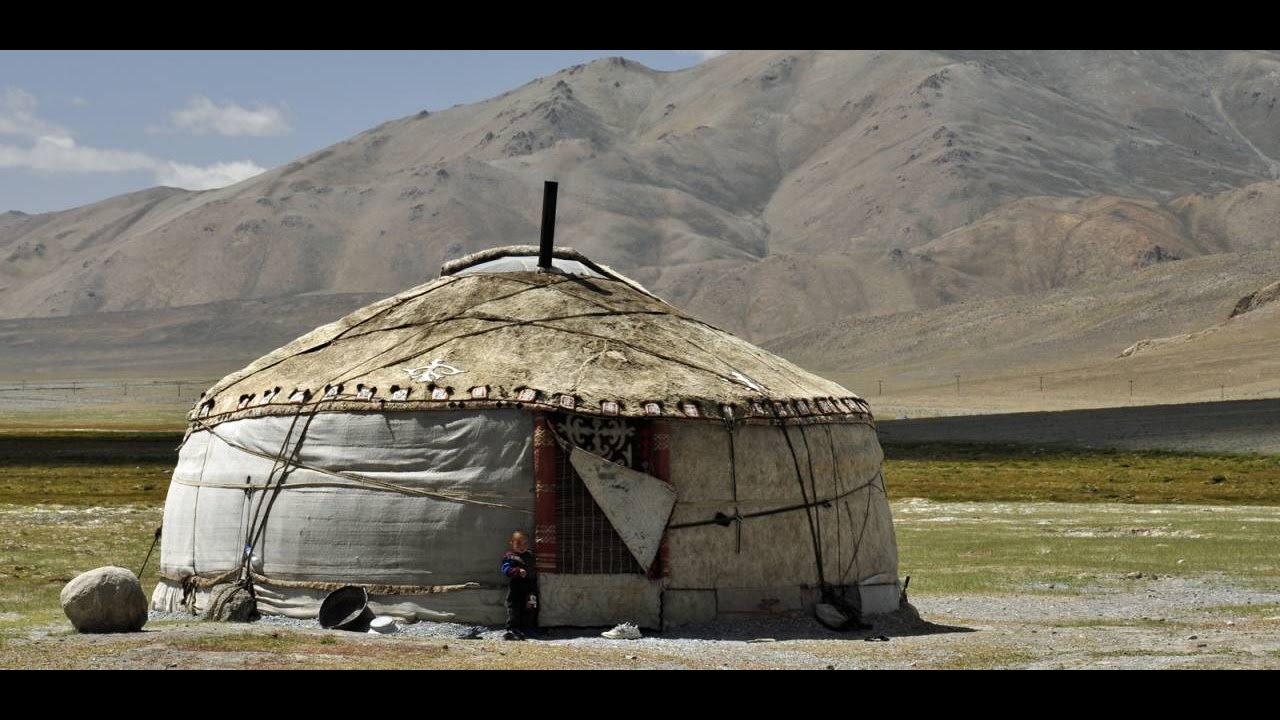
Other than the deformation of skulls, the other interesting feature of the Hephthalites is their polyandrous society. The records of brothers marrying to one wife had been reported from Chinese source.
The Extermination
Between 557 to 561 Persian King Chosroes allied with another steppe people who had appeared from inner Asia. Chorsoes wanted to profit from the situation to take revenge over the defeat of his grandfather Peroz; he married a daughter of the nomadic chief and allied himself with them against the Hephthalites. The chief Sinjibu was the boldest and strongest of all the tribes and he had the largest number of troops. It was he who conquered the Hephthalites and killed their king.
Mercilessly attacked on two sides, the Hephthalites were completely broken and disappeared by 565 that only small number of them survived. Some surviving groups living south of Oxus escaped Chosroes' grasp later fell to Arab invaders in the 7th century. One of the surviving groups fled to the west and may have been the ancestors of the later Avars in the Danube region. The decline of the Hephthalites marked a turning point in the story of the steppes. Another era was opening in Central Asia. For the allies of Chosroes were Western Turks, a new power was to dominate the steppe for next few centuries.
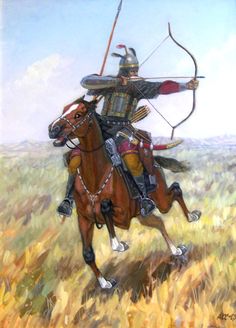
-------------
THE HEPHTHALITES
Richard Heli
A Western student's first encounter with the mysterious Ephthalites, or Hephthalites, or White Huns of Central Asia, is probably via the writings of Procopius, that contemporary of the Byzantine Emperor Justinian and fierce polemicist against his sovereign and the Empress Theodora. Procopius recorded the observations of an ambassador traveling east with Byzantium's sometime enemies, the Persians, who had chosen for a time, and from the Byzantine perspective very fortunately, to war against their eastern neighbors for a change, the Ephthalites: "The Ephthalites are of the stock of the Huns in fact as well as in name; however they do not mingle with any of the Huns known to us.... They are the only ones among the Huns who have white bodies and countenances which are not ugly." [Procopius]
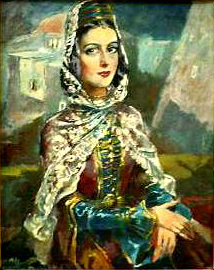
Thus, even in their very first appearance, the question of the origins of this people comes into doubt. For if they are Huns, how is it that the appearance of these "White Huns" differs so markedly from that of the Huns proper? This question was not one which Procopius, so far from the Ephthalites, was in any position to determine. That modern researchers can do better is largely due to the survival of writings on the other end of the Central Asian wasteland, by those who were closer to the point of origin and encountered this group early in its history, that is, the Chinese.
To the Chinese, they were the Ye-ti-i-li-do or Yeda, even though the Chinese chroniclers seem to realize that the people called themselves the people of Hua (the similarity to Hun may help explain the origin of "White Hun") and that the Chinese terms came actually from the name of the Hua leader. Like Procopius, contemporary Chinese chroniclers had their own theories about Ephthalite origins. One thought that were related in some way to the Visha (Indo-Europeans known to the Chinese as the "Yueh Chih"), another, a branch of the Kao-ch`ê, a third, descendants of the general Pahua, a fourth descendants of Kang Chu and a fifth admits that he cannot make clear their origins at all. This should not discourage as it is not in the theories of such writers that we may find value, but rather in their factual observations which may lead to the answer.
Japanese researcher Kazuo Enoki takes on the theories of both the ancient and the modern writers, including the redoubtable Stein, knocking the legs out from one after another. Theories which are based on coincidence of name, e.g. Pahua and Hua, are unlikely in this part of the world which exhibits so many languages and so much linguistic adaptation and orthographic variation, he points out, and should not be upheld if other sorts of evidence do not support the reasoning. Stein's contention that the Ephthalites were of the Hunnish tribe and therefore of Turkish origin is dismissed largely on this basis. On the other hand, J. Marquart finds similarities between the terms for the Ephthalites in India and words in the Mongolian language, but this theory requires so many leaps between tongues that it remains quite unconvincing. Finally, there is a whole school of researchers attempting to prove this tribe a Turkish, albeit non-Hun, one. These too must rely only on flimsy name evidence. Instead, Enoki makes a convincing case that the Ephthalites are actually an Iranian group. His theory, it must be admitted, does not explain all, but there seems little against it. More importantly, it relies first on data which is generally agreed upon, namely, ancient observations of Ephthalite geographical movements and culture.
For Enoki, Ephthalite origins may be determined by considering where they were not, as well as by where their conquests drove their enemies. They were not previously north of the Tien Shan, thus they did not stem from that region. They drove the Kidarites out of Balkh to the west, thus they came originally from the east. By such reasoning, the Ephthalites are thought to have originated at Hsi-mo-ta-lo (southwest of Badakhshan and near the Hindu Kush), which tantalizingly, stands for Himtala, "snow plain", which may be the Sanskritized form of Hephthal.
Turning to the elements of Ephthalite culture, Enoki notes that Procopius' comments on their appearance while not decisive, are in favor of an Iranian theory. Similarly, the seventh century travels of Hsuan Chwang show that he found no physical difference between the descendants of the Ephthalites and their known Iranian neighbors. As for their language, commentators made clear that it was neither Turkish nor Mongol, which also seems to support an Iranian origin.
Iranian customs also are common in the Ephthalite world. For example, the practice of several husbands to one wife, or polyandry, was always the rule, which is agreed on by all commentators. That this was plain was evidenced by the custom among the women of wearing a hat containing a number of horns, one for each of the subsequent husbands, all of whom were also brothers to the husband. Indeed, if a husband had no natural brothers, he would adopt another man to be his brother so that he would be allowed to marry. Conjugal rights were traded off and children were assigned in turn with the oldest husband receiving the first and so on. Tellingly, polyandry has never been associated with any Hun tribe, but is known of several Central Asian ones, including the Aryans in India, other Indo-Europeans and probably in prehistoric Iran.
In their religious beliefs, the Ephthalites are said to have worshipped fire and sun gods. While either one is not unusual in any early culture around the world, both together is likely to indicate a Persian origin. In Persia, such beliefs were later to culminate in Zoroastrianism.
As part of their religious observance, the Ephthalites did not cremate, but as is reported by all commentators including Procopius, always buried their dead, either by constructing a tomb or under the ground. This is not consistent with the Zoroastrian practice of leaving the body in the open, but is clearly at odds with Turkish nomadic groups. The practice of inhumation then may simply indicate an Iranian group which had been sundered from the main branch at an early date and had adopted local Central Asian burial customs.
The rocketlike political career of the Ephthalites may be traced in Appendix A. It may be seen that its enormous rapid successes came not only out of ferocity in battle, but also from shrewd diplomacy. Like the Arabs, the Vikings and others in the parade of history, they seem to appear virtually out of nowhere and amass for themselves a huge area. Of their language, only four words are known including "Ephthalite" itself, and these dubious. Their coins are putative at best, their arts, wholly unknown.
Despite their apparent talents for war and diplomacy, however, they appear to have been harsh rulers disliked by rebellious subjects and thus their legacy is brief. Persian Emperor Chosroes, faced with the choice of war against the Turks or conquest of the Ephthalites, hardly needed a moment to opt for the latter -- ironic if the Ephthalites truly had an Iranian origin. But such nationalistic ideas were not the rule in those times. Not much has been written about their dramatic story since 1966, but Enoki hints that from the translation and study of possible Ephthalite documents unearthed at Lou Lan, we may someday learn more about this mysterious and fascinating people. Let us hope it will be so.
Appendix A: Approximate Timeline. [Enoki, McGovern]
420-427 Ephthalites raid Persia as far west as modern Tehran.
427 Ephthalites suffer overwhelming defeat in Persia.
437 Chinese embassy to Tokharistan (area around Balkh) and Gandhara finds no sign of Ephthalites.
454 Ephthalites revenge earlier loss to Sassanid Persians.
456 Ephthalites send their first embassy to the Chinese.
457 Firuz (Peroz), former king of Persia, requests Ephthalite assistance.
459 Firuz regains Persian throne with help of Ephthalite armies.
464-475 Wars between the former allies resolved with Persian tribute in 475.
465-470 Ephthalites conquer Gandhara, set up a Tegin (a viceroy).
470-480 War between Tegin of Gandhara and Gupta Empire of India.
473-479 Ephthalites conquer Sogdiana, driving the Kidarites westwards. Next conquering Khotan and Kashgar (in the Tarim Basin).
480-500 Gupta empire collapses. Tegin is overlord of North & Central India.
484 Firuz initiates new war against the Ephthalites which fails miserably.
486 Firuz' heir Kubad takes refuge with Ephthalites following a coup.
488 Kubad regains the throne with Ephthalite assistance.
493-508 Ephthalites extend power as far as Zungaria, then Turfan and Karashar (in modern China).
497 Kubad deposed and escapes to a second refuge with the Ephthalites.
500 Ephthalites place Kubad on Sassanid throne a second time (dies 531).
503-513 Kubad makes war on the Ephthalites. Peace in 513 lasts.
522 Apex of Ephthalite power. Chief of the Juan-Juan nomads flees to the Ephthalites for protection. Ephthalites dominate north and south of the Tien Shan range. Control as far as Tieh-lo in the south, Ci`ih-le^ (Kao-ch`e^) in the north, at least to Khotan in the east probably more, and up to Persia in the west. A separate Ephthalite Empire controls much of India. Forty countries (including Sassanid Persia) are in tribute. Ephthalite centers are at Ghur, Balkh, Warwaliz (north of today's Kunduz near the source of the Oxus) and Hsi-mo-ta-lo. The entire empire probably comprises fifty to sixty thousand individuals.
531 Chosroes succeeds his father Kubad in Persia.
532 Revolts in India; Ephthalites lose most of East & Central India.
532-542 Fleeing ruler conquers the Kashmir for a short reign.
552 Turks overthrow Avars and begin petty conflicts with Ephthalites.
c. 565 Turks and Chosroes (Khusrau) of Persia ally to capture and divide Ephthalite empire.
c. 570 Ephthalite rule overthrown in India.
Appendix B: Bibliography.
• Enoki, Kazuo, Memoirs of the Research Department of the Toyo Bunko, 1955, No. 18, "On the Nationality of the Ephthalites"
• Hambly, Gavin, Central Asia, 1966, Chapter 3: "Sassanians and Turks in Central Asia"
• McGovern, William, The Early Empires of Central Asia, 1939, Chap. 18: "The Huns in Persia and India," pp. 399-419, and notes, pp. 454-457.
• Procopius, History of the Wars, Books I and II, Loeb Classical Library, vol. 1, pp. 12-15
----
PART-1 can be found here: Historical Background of Pakistan and its People/Rarely part of India/IVC
PART-2: Coming of the Aryans/ Persian Rule
PART-3: Alexander the Great/ Mauryans/ Graeco-Bactrians
----
PART-4
THE SAKAS

The Graeco-Bactrian rule, like that of its predecessor the Mauryan, did not last for more than a century. Internecine warfare and internal schisms soon weakened them. Pakistan was divided into several petty Greek Kingdoms which easily fell victim to the great wave of Scythians (Sakas) which took place in the middle of the first century B.C. This was a huge sea of nomads which, pressed in Central Asia and on China's borders by fiercer and tougher people migrated on an extensive scale. They overthrew the Greek rulers and established their sovereignty as well as settlements all over Pakistan.
Pakistan began to receive many waves of Sakas and Parthians. In the next stage beginning from 1st century B.C. wave after wave of the people such as the Kushans, the White Huns and the Gujjars also began to settle in Pakistan. In the course of time, all of these groups constituted an overwhelmingly predominant element of its population. This composition continues to this day. These waves were so large and cataclysmic that everything was sub-merged in it or absorbed by it. The waves of Sakas were so enormous and their settlements so vast that Pakistan came to be known to Greek geographers as Scythia and in Indian literature as Saka-dipa.
The first three Saka kings of Pakistan were Maues, Azes I and Azilises. Their numerous coinages are, almost without exception, copied from those of their Yavana (Greek) predecessors. As regards language and culture, the Sakas mostly adopted those of the Pahlavas or Parthians of Iran. In fact at a later stage Saka-dipa (Pakistan) was ruled by Pahlava princes. The most well-known of them was Gondopharnes whose capital was Taxila. During his reign (20-48 A.D.) St. Thomas, according to early ecclesiastical legends, preached Christianity in his dominions.

"Of the political history of this period a great deal is still in suspense. The leaders of the Sakas in the Indus basin seem to have first acknowledged the power of the local Greek Indian rulers. It is not until a few decades later that they felt themselves strong enough to lay claim to supreme suzerainship. Ghandara became the centre of the Saka domains, and the eastern Capital city of Taxila was chosen by the Saka king Mavak (Maues or Mauakes in the ancient authors, and Moga in early Indian sources) in the middle of the first century B.C. as its residence. Mavak's successors propagated their power over a considerable part of the Punjab.
"In the north-west in the Punjab, however, the Saka leaders' hold was shortlived. The dynasty founded by Mavak was overthrown by the Parthians as early as the beginning of the first century of our era.
"In the Western Punjab, Upper Sind and Derajat, a number of warring rulers related to the Surens, a Parthian clan controlling the eastern areas of Iran, held sway. The Parthian Kings, who keep ousting one another, rule over this country" (The Peoples of Pakistan, By Yu.V.Gankovsky).

SAKA ORIGIN
The Scythians inhabiting Central Asia at the time of Herodotus (5th century B.C.) consisted of 4 main branches known as the MassaGatae, Sacae, Alani, and Sarmatians, sharing a common language, ethnicity and culture. Ancient Greek (e.g. Herodotus, Pliny, Plotemy, Arrian) and Persian sources (Darius's historians) from the 5th century place the MassaGatea as the most southerly group in the Central Asian steppe. The earliest Scythians who entered the northern regions of South Asia were from this group.
Historians derive "Jat" from "Gatae", "Ahir" from "Avar", "Saka" from "Scythii", "Gujjar" from "Khazar", "Thakur" from "Tukharian", "Saurashtra" from "Saura Matii" or "Sarmatians", "Sessodia" (a Rajput clan) from "Sassanian", "Madra" from "Medes", "Trigartta" from "Tyri Getae" and "Sulika" from "Seleucids". "Massa" means "grand" or "big" in old Iranian - the language of the Scythians.
The early Sakas or Scythians are remembered by Greek (e.g. Herodotus, Megatheses, Pliny, Ptolemy) and Persian historians of antiquity as tall, large framed and fierce warriors who were unrivalled on the horse. Herodotus from the 5th century BC writes in an eye-witness account of the Scythians: "they were the most manly and law-abiding of the Thracian tribes. If they could combine under one ruler, they would
be the most powerful nation on earth." According to their origin myth recorded by Herodotus, the Sakas arose when three things fell from the sky: the i) plough, ii) sword and iii) cup. The progenitor of the Sakas picked them up and hence the Saka race began its long history of conquering lands, releasing its bounties and enjoying the fruits of their labor (the cup has a ceremonial-spiritual-festive symbolism). The relevance of these symbols and codes of life and culture to the traditional Punjabi and northwest society are tantalizingly obvious. A branch of the Sakas kown as the Alani reached regions of Europe, Asia Minor and the Middle East. They have been connected to the Goths of France/Spain, Saxons and the Juts of Denmark.

Entry into Southasia
Some of these Saka tribes entered northwest Southasia through the Khyber pass, others through the more southerly Bolan pass which opens into Dera Ismail Khan in Sindh. From here some invading groups went north, others went south, and others further east. This explains why some Jat, Gujjar and Rajput clans claim descent from Rajasthan (Chauhan, Powar, Rathi, Sial etc.) while others from Afghanistan (e.g. Mann, Her, Bhullar, Gill, Bajwa, Sandhu, etc.). This is supported by the fact that the oldest Rajput geneologies (10th centuries) do not extend into the northwest's Gandharan Buddhist period (400 B.C. - 900 AD).
Sir Cunningham (former Director General of Indian Archeological survey) writes:
"the different races of the Scythians which succesively appeared as conquerors in the
border provinces of Persian and India are the following in the order of arrival: Sakas or Sacae (the Su or Sai of the Chinese - B.C. ?), Kushans (the great Yue-Chi (Yuti) of the Chinese - B.C. 163), Kiddarite or later Kushans (the little Yue-chi of the Chinese -A.D. 450) and Epthalites or White Huns (the Yetha of the Chinese - 470 A.D.).
Cunningham further notes that
". . . the successive Scythian invasions of the Sakas, the Kushans, and the White Huns,
were followed by permanent settlements of large bodies of their countrymen . . ".
Cunningham and Tod regard the Huns to be the last Scythian wave to have entered India.
Herodotus reveals that the Scythians as far back as the 5th century B.C. had political control over Central Asia and the northern subcontinent up to the river Ganges. Later Indo-Scythic clans and dynasties (e.g. Mauryas, Rajputs) extended their control to other tracts of the northern subcontinent.
According to Ethnographers and historians like Cunningham, Todd, Ibbetson, Elliot, Ephilstone, Dahiya, Dhillon, Banerjea, etc., the agrarian and artisan communities (e.g. Jats, Gujars, Ahirs, Rajputs, Lohars, Tarkhans etc.) of the entire west are derived from the war-like Scythians who settled north-western and western South Asia in successive waves between 500 B.C. to 500 AD. Down to this day, the very name of the region `Gujarat' is derived from the name `Khazar', whilst `Saurashtra' denotes `Sun-worshipper', a common term for the Scythians. The northwest Southasian region continues to be the most Scythic region in the world.
The oldest Rajputs clans arose much later from earlier Scythic groups; or are of Hun origin (5-6th century AD); and many are no doubt of mixed Scythic-Hun origin. Virtually all are of Scythic descent.
----------------------------
The Sakas - Indo-Scythians
Jason Neelis

Saka nomads from Central Asia migrated to the northwest of South
Asian subcontinent in the first and second centuries BCE. Herodotus
(4.1-142) describes the extent, customs, and origins of various
groups of Scythians (designation for Sakas in Western classical
sources) who inhabited large areas of the steppes of Central Asia on
the northern peripheries of the Greek world. The Sakas are also
known from Old Persian inscriptions of the Achaemenid Empire. The
Naqs-i-Rustam inscription of Darius I distinguishes three groups of
Sakas:

1) Saka Tigraxauda: "Sakas wearing the pointed cap" who are
portrayed in a sculpture at Behistun and described by Herodotus
(7.64) as "clad in trousers" and having "on their heads tall stiff
caps rising to a point"; these Sakas lived between the Caspian Sea
and the Jaxartes River (Syr Daria);
2) Saka Haumavarga: "hauma-drinking" or "hauma-preparing" Sakas
(hauma is a type of alcoholic beverage) identified with the Amyrgian
Scythians of Greek sources, possibly located in the southeastern
Iranian province of Drangiana, which later became known as Sakastan
or Seistan;
3) Saka Paradraya: Sakas "across the sea" who probably lived north
of the Black Sea and in the Russian steppes, although some groups
reached the Danube Valley in central Europe, Syria, and upper
Mesopotamia.

Chinese historical annals refer to the movements of the Sai (Chinese
designation for Sakas) southwards into northwest of South Asia
following a period of disturbances in Central Asia during the second
century BCE. According to the History of the Former Han (Han shu),
covering the period from 206 BCE to 25 CE: "When, formerly, the
Hsiung-nu [Xiongnu] conquered the Yueh-chih [Yuezhi] the latter
moved west and established themselves as masters of Ta Hsia [Da
xia]; it was in these circumstances that the king of the Sai moved
south and established himself as master of Chi-pin [Jibin]. The Sai
tribes split and separated and repeatedly formed several states."1
The westward migrations of the Yuezhi (see Kushan essay) led to the
emigration of the Sai sometime before 128 BCE, when the Han
ambassador Zhang Qian arrived in Sogdia and Bactria to make an
alliance with the Yuezhi. Saka migrations were not led by a single
king, but were probably gradual movements of acephalous groups to
Jibin, a region apparently corresponding to Gandhara or to northwest
of South Asia in general.
At the beginning of the first century BCE, two or possibly three
groups of Sakas migrated to South Asia from Central Asia:
a) Sakas from the north (perhaps coming from Khotan) took the 'Pamir
routes' through the Karakorum Mountains to Swat and Gandhara;
b) Sakas crossed the Hindu Kush under pressure from the Yuezhi to
mountain valleys of northeastern Afghanistan;
c) Sakas coming from the southwest (Sakastan) took control of modern
Sindh in southern Pakistan.
Maues was one of the earliest Indo-Scythian rulers during the early
first century BCE. His name is preserved in bilingual Greek (Maues)
and Kharosthi (Moa) coins and a Kharosthi inscription from Taxila
(Moga). Maues' origins are obscure: he may have been connected with
the Sakas of Sakastan, or he could have belonged to another branch
of Sakas that migrated from the north through the mountains to
Gandhara and Taxila. In giving himself the title of "King of Kings"
in bilingual Greek and Kharosthi coin legends, Maues imitated
Parthian royal titles. A Kharosthi inscription on a copper plate
from Taxila dated in year 78 of an unspecified era during the reign
of "maharaja Moga the Great" records the establishment of Buddhist
relics by a donor named Patika, the son of an official (ksatrapa)
named Liaka Kusulaka. The inscription demonstrates that Liaka
Kusulaka acknowledged the authority of Maues as his overlord.
Decentralized administration continued after the period of Maues
under loosely affiliated officials who acknowledged a more powerful
leader.
Numismatic sequences and inscriptions show that Azes followed Maues
as the most powerful Indo-Scythian ruler in 58 BCE, a date
corresponding to the beginning of the so-called "Vikrama" era, which
is still used in India. Like his predecessor, Azes adopted the title
of "King of Kings" and iconography of Greek and Indic gods and
goddesses from the coins of contemporary Indo-Greeks. Indo-Greek
power in territories of central Afghanistan and eastern Punjab
rapidly diminished during the second half of the first century BCE
as Indo-Scythians predominated. Azes and his successors Azilises and
Azes II administered Taxila and other areas of Pakistan and
northwestern India through regional rulers with Iranian, Greek, and
Indian titles.
Another branch of Indo-Scythians called the "Western Ksatrapas"
ruled parts of western India from the first century BCE to the end
of the fourth century CE. The Western Ksatrapas vied with the
Satavahanas, another regional dynasty in western India, to control
trade routes between the Deccan Plateau and ports on the west coast.
This area flourished due to lucrative long-distance trade across the
Indian Ocean to the Red Sea and Mediterranean (described in the
Periplus Maris Erythraei). The Western Ksatrapas and other ruling
families and groups of merchants supported Buddhist cave monasteries
clustered along routes through the Western Ghats (see essay on
Buddhism and Trade). Ujjayini in central India was the center of the
Western Ksatrapas from the second to early fourth centuries, until
the Gupta ruler Candragupta II defeated the "Sakas" between ca. 395-
400 CE.
Sakas in control of major commercial centers along the "Northern
Route" (Uttarapatha) and "Southern Route" (Dakshinapatha) encouraged
the development of trade networks and supported religious
institutions. Inscriptions that record the establishment of Buddhist
relics and donations to monasteries in Gandhara, Taxila, Mathura,
and western South Asia show that Sakas, Parthians, and other
Iranians were active lay supporters of the Buddhist community. Saka
support of Buddhism did not preclude their patronage of other
religious traditions or imply that their old beliefs were abandoned.
Iranian elements in architecture, iconography, languages, and many
other spheres of South Asian life around the beginning of the Common
Era are easy to recognize. Concurrent with their impact in South
Asia, migrations of the Sakas during the last two centuries BCE and
the Kushans in first century CE from Central Asia to northwest of
South Asia eventually led to the transmission of Buddhism in the
other direction to Central Asia and East Asia.

(1) Translation of Anthony F.P. Hulsewe in China in Central Asia.
The Early Stage: 125 B.C. - A.D. 23 (An Annotated Translation of
Chapters 61 and 96 of the History of the Former Han Dynasty).
Leiden: E.J. Brill, 1979, pp. 104-5. Pinyin equivalents in brackets
correspond to the Wade-Giles transliterations.
-----
THE KUSHANS
The next important chapter in Pakistan's history begins with the arrival of another wave of Central Asian tribes called the Yueh-chi. Because of the turbulent and unsettled conditions on the borders of China, one tribe was chasing out the other and occupying their grazing lands. One such movement brought the Yueh-chi to Pakistan, a branch of which was known as the Kushans. This was about the middle of the first century A.D.

The Kushans overthrew the Saka-Parthian princes and established an empire which became one of the world's greatest and most distinguished both from the point of view of territory as well as cultural and religious achievements. The Kushan ruler who Conquered Pakistan was Vima Kadphises who was succeeded in about 78 A.D. by Kanishka. The Kushan rule, however, did not completely eliminate the Sakas from Pakistan. They had permanently settled down in these areas in large numbers and continued to be governed by their princes who merely extended allegiance to the Kushan kings.This is proved by the Sue Vihara inscription in the Bahawalpur Division which is dated in the regnal year of Kanishka 11(89 A.D.). Even the era said to have been founded by Kanishka in 78 A.D. was known as Saka Era. "There is evidence to show that they (Sakas) still governed their own states, no doubt as feudatories more or less nominal of the Kushans" (Cambridge History of India, Vol.1, edited by E.J. Rapson).
The Kushans, with their capital at Purushapura (Peshawar) had their dominions on both sides of the Hindu Kush i.e., extending up to and including parts of Turkistan in the north-west, embracing the whole of modern Afghanistan, and in the east the entire Pakistan and major portion of northern India. The greatest ruler of the dynasty, Kanishka, had adopted Buddhism and it was during his period that both Buddhist religion and Greek art reached their zenith which is known under the nomenclature of Gandhara Civilization. It was again during his regime and because of his efforts that Buddhism spread in Central Asia and China. This period is regarded as the most important in the history of Buddhism.
The budding and blossoming of Gandhara art was not a new phenomena in Pakistan's history as this land had given birth to several such brilliant civilizations since pre-historic times beginning with Indus Valley Civilizadon. Judeiro Daro and Shahi Tump in Baluchistan; Moenjo Daro, Kot Diji, Amri, Chanhu Daro, and Sehwan in Sind; Harappa, Sari Kola and Taxila in the Punjab, Takht-i-Bahi and Mingora in NWFP have been seats of learning and art, centres of great religious activity and pivots of political power. It may be pointed out that Sari Kola in Pindi Division (3000 B.C.), Kot Diji in Khairpur Division (2800 B.C.) and Amri in Dadu District (3000 B.C.) are all pre-Indus Valley civilizations.
"When the great monarch Kanishka actively espoused the cause of Buddhism and essayed to play the part of a second Ashoka, the devotion of the adherents of the favoured creed received an impulse which speedily resulted in the copious production of artistic creations of no small merit.

"In literature the memory of Kanishka is associated with the names of the eminent Buddhist writers Nagarjuna, Asvaghosha and Vasumitra. Asvaghosha is described as having been a poet, musician, scholar, religious controversialist and zealous Buddhist monk. Charaka, the most celebrated of the early Indian authors treating of medical science, is reputed to have been the court physician of Kanishka.
"Architecture, with its subsidiary art of sculpture, enjoyed the liberal patronage of Kanishka, who was like Ashoka a great builder. The tower at Peshawar built over the relics of Buddha and chiefly constructed of timber stood 400 feet high. The Sirsukh section of Taxila hides the ruins of the city built by Kanishka. A town in Kashmir, still represented by a village bore the King's name" (Oxford History of India, by V.A. Smith).
A unique feature of Kanishka's empire was that with the capital at Peshawar its frontiers touched the borders of all the great civilizations of the time, while its Central Asian provinces lay astride the Roman Middle East-Chinese trade routes. Roman Empire during the days of Trajan and Hadrian (98-138 A.D.) had expanded furthest East almost touching Pakistan's Kushan Empire. Similarly, Kanishka's conquests had brought Khotan,Yarkand and Kashgar within Pakistan's jurisdiction effecting direct contact with China. This was one of the most important factors in providing impetus to art and architecture, science and learning in Pakistan. The best specimen of Graeco-Roman art discovered in and around Peshawar, Swat and Taxila belong to this period, mostly executed during the 2nd century A.D. in the reigns of Kanishka and his son Huvishka. The Kushans exchanged embassies with the Chinese as well as the Romans. Mark Antony had sent ambassadors, and the Kushans sent a return embassy to the court of Augustus "In the middle of the first century of our era, one of the Tokhari princes belonging to the Kushans, Kujula Kadphises, unified the dispersed Tokhari principalities. As he grew stronger, the leader of the Kushans extended his suzerainship to the lands south of the Hindu Kush, in the Kabul Basin and on the Upper Indus. Kujula Kadphises's successors, the most prominent of whom was Kanishka (circa A.D. 78-120) kept on the expansive policy of his subcontinent (Kashmir, the Punjab and Sind). The rulers of Gujrat, Rajasthan and the states lying in the Ganges-Jumna doab were the vassals of the Kushan kings. The Kushan kings also held control of the territory of the present day Afghanistan, Kashgar, Khotan, Yarkand and the southern areas of Middle Asia. Gandhara i.e., the territory lying in the valleys of the Kabul and the Middle Indus, became the centre of a vast empire. The city of Purushapura (the present-day Peshawar) is known to have been the capital of Kanishka.

"The Kushan empire dissolved in the third century of our era. The Iranian shahs of the Sassanid dynasty took in the western territories. Various dynasties of Middle Asia took hold of the lands north of the Hindu Kush" (The Peoples of Pakistan, By Yu.V.Gankovsky).
After ruling for over two hundred years from the middle of the 1st century A.D. to the middle of the 3rd century A.D. the Kushan Empire collapsed. Already, a few decades earlier, its frontiers had shrinked to those of Pakistan having shed the territories beyond Hindu Kush in Central Asia and eastward of Sutlej in India. The final blow was administered by Shahpur I, the head of a new dynasty of Sassanians that had emerged in Iran in 226 A.D. after a long period of anarchy prevailing for over 500 years since Alexander had eliminated the Achaemenians. "Shahpur I clearly includes in his Empire the greater part of Pakistan. Shahpur's son Narses had been made Shah of Seistan, Baluchistan and Sind and the seashore i.e., Pakistan and a bit more" (Pakistan in early Sassanian times, By M. Sprengling).
But this time Iran could not keep its sway over Pakistan for long. Though defeated, Kushans continued to rule over Pakistan for a considerably long period with the smaller kingdoms still retained by the redoubtable Sakas---both being Central Asian tribes. It seemed that ethnically and politically the Central Asian elements had become a permanent feature of Pakistan. Strong Kushan-Saka dynasties continued to exist in Kabul and Pakistan until another great event in the history of this area i.e., the Hun invasions in the 5th century A.D.-----some principalities survived even till the Arab conquest.
An important development had taken place in the neighbouring Country of India a little earlier which deserves our attention. Buddhism, which was on the decline from the 3rd century A.D. onward was overthrown by Hinduism reasserting its lost hegemony. This process culminated with the coming into power of the Guptas by the end of the 4th century A.D. A point of considerable significance to be noted here is that though the Gupta Empire is considered one of the most glorious in the annals of Hindu history covering a vast area of this sub-continent, yet it could not bring Pakistan under its tutelage. During the Gupta period, Pakistan was in the hands of Kushan Shahis and Sassanians. Even during Samudragupta's triumphal career this region remained independent of India. "Samudragupta did not attempt to carry his arms across the Sutlej or to dispute the authority of the Kushan kings who continued to rule in and beyond the Indus basin...... Gupta Empire---the greatest in India since the days of Ashoka-extended in the north to the base of the mountains, but did not include Kashmir" (Oxford History of India).
----
WHITE HUNS (Hephthalites)
Coming back to the Hun invasion it may be mentioned that this was also, like that of the Sakas, one of the greatest migrations of Central Asian nomadic tribes in the history of Pakistan and the sub-continent. The particular branch of the Huns which was encamped in the Oxus Valley and which came to Pakistan was known as Epthalite or White Huns. They were accompanied by a number of other tribes including Gurjaras. They started coming in wave after wave from the middle of the 5th century A.D. and very soon became rulers of Pakistan. One of their mighty rulers was Mehar Gul (Sunflower) whose capital was Sakala, Sialkot.

The mass immigration of Huns and Gurjaras extending over the 5th and the 6th centuries constitutes a turning point in the history of Pakistan and of northern India both politically and socially. Politically because henceforth, till the arrival of Muslims, they were the ruling class in Pakistan and in most of northern India. Socially because the origin of majority of the tribes of Pakistan and those of Rajputana is traceable to them. "No authentic family or class traditions go back beyond the Hun invasion. All genuine tradition of the earlier dynasties has been absolutely lost. The history of the Mauryas, Kushans and Guptas, so far as it is known has been recovered labourously by the researches of scholars, without material help from living tradition." (Ibid). Many of Afghan-Pathan tribes and most of the Rajput and Jat clans of the Punjab and Sind are, according to modern scholars, descended from the Epthalites i.e., White Huns.
There was a period of confusion forming the transition from one age to another. Pakistan and north India had left the Early Period of history and entered what is generally termed as the Medieval Period. During the transition the hordes of foreign invaders were gradually absorbed into the Hindu body politic and new grouping of states began to evolve. This period was marked by the development of the Rajput clans never heard of in earlier times. They began to play highly prominent role after the death of Harsha so much so that the 500-year period from the 7th century A.D. to the 12th century A.D. (i.e., till the arrival of Muslim Turks) may be called the Rajput period.
The Hun invasions and their consequences broke the chain of historical tradition. Living clan traditions rarely if ever go back beyond the 8th century and few go as far. The existing clan-castes only began to be formed in the 6th century. The Brahmans found their advantage in treating new aristocracy, whatever its social origin, as representing the ancient Kshatriya class of the scriptures, and the novel term Raja-putra or Rajput, meaning king's son, or member of a ruling family or clan came in use as an equivalent of Kshatriya." (Oxford History of India).

During this 500-year period, again, Pakistan was under quite independent Rajput kingdoms separate from those of India. Even the Gurjara-Pratihara Empire of northern India which was one of the most important formed during this period did not include Pakistan, not even during the days of its greatest and most powerful king Raja Bhoja. "The rule of the Pratiharas had never extended across the Sutlej, and the history of the Punjab between the 7th and 10th centuries A.D. is extremely obscure." (Ibid). At some time during this period, a powerful kingdom had been formed in Pakistan which extended from the mountains beyond the Indus, eastwards as far as the Hakra or 'lost river' in East Punjab so that it comprised a large part of the NWFP and the Punjab. At the time Mahmud Ghaznavi came into power at the end of the 10th century A.D. this kingdom was still in existence and it was with its ruler Raja Jaipal that he came into clash.
White Huns - Hephthalites
Silk Road Foundation
The Origin of Hephthalites
The paucity of record in Hephthalites or Ephthalites provides us fragmentary picture of their civilization and empire. Their background is uncertain. They probably stemmed from a combination of the Tarim basin peoples and the Yueh-chih. There is a striking resemblance in the deformed heads of the early Yueh-chih and Hephthalite kings on their coinage. According to Procopius's History of the Wars, written in the mid 6th century - the Hephthalites

"are of the stock of the Huns in fact as well as in name: however they do not mingle with any of the Huns known to us. They are the only ones among the Huns who have white bodies...."
Ephthalites was the name given by Byzantine historians and Hayathelaites by the Persian historian Mirkhond, and sometimes Ye-tai or Hua by Chinese historians. They are also known as the White Huns, different from the Hun who led by Attila invading the Roman Empire. They are described as a kindred steppe people originally occupied the pasture-lands in the Altai mountain of southwestern Mongolia.

Toward the middle of the 5th century, they expanded westward probably because of the pressure from the Juan-juan, a powerful nomadic tribe in Mongolia. Within decades, they became a great power in the Oxus basin and the most serious enemy of the Persian empire.
The Westward Expansion and War with Sassanian Empire
At the time when the Hephthalites gained power, Kushan and Gandhara were ruled by the Kidarites, a local dynisty of Hun or Chionites tribe. The Hephthalites entered Kabul and overthrew Kushan. The last Kidarites fled to Gandhara and settled at Peshawar. Around 440 the Hephthalites further took Sogdian (Samarkand) and then Balkh and Bactria.
The Hephthalites moved closer and closer toward Persian territory. In 484 the Hephthalite chief Akhshunwar led his army attacked the Sassanian King Peroz (459-484) and the king was defeated and killed in Khurasan. After the victory, the Hephthalite empire extended to Merv and Herat, which had been the regions of the Sassanid Empire. The Hephthalites, at the time, became the superpower of the Middle Asia. They not only destroyed part of Sassanian Empire in Iran but also intervened in their dynastic struggles when the Sassanid royal, Kavad (488-496), was fighting for the throne with Balash, brother of Peroz. Kavad married the niece of the Hephthalites chief and the Hephthalites aided him to regain his crown in 498.

After conquest of Sogdia and Kushan, the Hephthalites founded the capital, Piandjikent, 65 kilometers south-west of Samarkand in the Zaravshan valley. This city later reached its prosperity, produced one of the best mural paintings in the seventh century and later was destroyed by the Arabs. The Hephthalites chose Badakshan as their summer residence. Their chiefs lived north of the Hindu Kush, migrating seasonlly from Bactria where they spent the winter, to Badakshan, their summer residence. Under the Hephthalite control, the Bactrian script and language continued to be used and trade and commerce flourished as previously.
The Eastward Expansion to the Tarim Basin
With the stabilization at the western border, the Hephthalites extended their influence to the northwest into the Tarim Basin. From 493 to 556 A.D., they invaded Khotan, Kashgar, Kocho, and Karashahr. The relationship with Juan-juan and China were tightened. The Chinese record indicated that between 507 and 531, the Hephthalites sent thirteen embassies to Northern Wei (439-534) by the king named Ye-dai-yi-li-tuo.
Invasion to India

During the 5th century, the Gupta dynasty in India reigned in the Ganges basin with the Kushan empire occupied the area along the Indus. India knew the Hephthalite as Huna by the Sanskrit name. The Hephthaltes or Hunas waited till 470 right after the death of Gupta ruler, Skandagupta (455-470), and entered the Inda from the Kabul valley after the conquest of Kushan. They mopped on along the Ganges and ruined every city and town. The noble capital, Pataliputra, was reduced in population to a village. They persecuted Buddhists and burned all the monasteries. Their conquest was accomplished with extreme ferocity and the Gupta regime (414-470) was completely extinguished.
For thirty years the northwestern India was ruled by Hephthalite kings. We learned some of the Hephthalite kings ruling India from coins. The most famous ones were Toramana and Mihrakula ruling India in the first half of the 6th century.
The Language
There are numerous debates about Hephthalite language. Most scholars believe it is Iranian for the Pei Shih states that the language of the Hephthalites differs from those of the Juan-juan (Mongoloid) and of the "various Hu" (Turkic); however there are some think the Hephthalites spoke Mongol tongues like the Hsien-pi (3rd century) and the Juan-juan (5th century) and the Avars (6th-9th century). According to the Buddhist pilgrims Sung Yun and Hui Sheng, who visited them in 520, they had no script, and the Liang shu specifically states that they have no letters but use tally sticks. At the same time there is numismatic and epigraphic evidence to show that a debased form of the Greek alphabet was used by the Hephthalites. Since the Kushan was conquested by Hephthalites, it is possible they retained many aspects of Kushan culture, including the adoption of the Greek alphabet.
The Religion
It is equally inconsistent while comparing the references to the Hephthalites' religion. Although Sung Yun and Hui Sheng reported that the Hephthalites did not believe in Buddhism, though there is ample archaeological evidence that this religion was practiced in territories under Hephthalite control. According to Liang shu the Hephthalites worshiped Heaven and also fire - a clear reference to Zoroastrianism. However the burials found seem to indicate the normal practice in disposing of the dead, which is against Zoroastrian belief.
The Customs
Very little was known about these Hephthalite nomads. Little art has left from them. According to Sung Yun and Hui Sheng who visited their Hephthalite chief at his summer residence in Badakshan and later in Gandhara,
The Hephthalites have no cities, but roam freely and live in tents. They do not live in towns; their seat of government is a moving camp. They move in search of water and pasture, journeying in summer to cool places and in winter to warmer ones....They have no belief in the Buddhist law and they serve a great number of divinities."

Other than the deformation of skulls, the other interesting feature of the Hephthalites is their polyandrous society. The records of brothers marrying to one wife had been reported from Chinese source.
The Extermination
Between 557 to 561 Persian King Chosroes allied with another steppe people who had appeared from inner Asia. Chorsoes wanted to profit from the situation to take revenge over the defeat of his grandfather Peroz; he married a daughter of the nomadic chief and allied himself with them against the Hephthalites. The chief Sinjibu was the boldest and strongest of all the tribes and he had the largest number of troops. It was he who conquered the Hephthalites and killed their king.
Mercilessly attacked on two sides, the Hephthalites were completely broken and disappeared by 565 that only small number of them survived. Some surviving groups living south of Oxus escaped Chosroes' grasp later fell to Arab invaders in the 7th century. One of the surviving groups fled to the west and may have been the ancestors of the later Avars in the Danube region. The decline of the Hephthalites marked a turning point in the story of the steppes. Another era was opening in Central Asia. For the allies of Chosroes were Western Turks, a new power was to dominate the steppe for next few centuries.

-------------
THE HEPHTHALITES
Richard Heli
A Western student's first encounter with the mysterious Ephthalites, or Hephthalites, or White Huns of Central Asia, is probably via the writings of Procopius, that contemporary of the Byzantine Emperor Justinian and fierce polemicist against his sovereign and the Empress Theodora. Procopius recorded the observations of an ambassador traveling east with Byzantium's sometime enemies, the Persians, who had chosen for a time, and from the Byzantine perspective very fortunately, to war against their eastern neighbors for a change, the Ephthalites: "The Ephthalites are of the stock of the Huns in fact as well as in name; however they do not mingle with any of the Huns known to us.... They are the only ones among the Huns who have white bodies and countenances which are not ugly." [Procopius]

Thus, even in their very first appearance, the question of the origins of this people comes into doubt. For if they are Huns, how is it that the appearance of these "White Huns" differs so markedly from that of the Huns proper? This question was not one which Procopius, so far from the Ephthalites, was in any position to determine. That modern researchers can do better is largely due to the survival of writings on the other end of the Central Asian wasteland, by those who were closer to the point of origin and encountered this group early in its history, that is, the Chinese.
To the Chinese, they were the Ye-ti-i-li-do or Yeda, even though the Chinese chroniclers seem to realize that the people called themselves the people of Hua (the similarity to Hun may help explain the origin of "White Hun") and that the Chinese terms came actually from the name of the Hua leader. Like Procopius, contemporary Chinese chroniclers had their own theories about Ephthalite origins. One thought that were related in some way to the Visha (Indo-Europeans known to the Chinese as the "Yueh Chih"), another, a branch of the Kao-ch`ê, a third, descendants of the general Pahua, a fourth descendants of Kang Chu and a fifth admits that he cannot make clear their origins at all. This should not discourage as it is not in the theories of such writers that we may find value, but rather in their factual observations which may lead to the answer.
Japanese researcher Kazuo Enoki takes on the theories of both the ancient and the modern writers, including the redoubtable Stein, knocking the legs out from one after another. Theories which are based on coincidence of name, e.g. Pahua and Hua, are unlikely in this part of the world which exhibits so many languages and so much linguistic adaptation and orthographic variation, he points out, and should not be upheld if other sorts of evidence do not support the reasoning. Stein's contention that the Ephthalites were of the Hunnish tribe and therefore of Turkish origin is dismissed largely on this basis. On the other hand, J. Marquart finds similarities between the terms for the Ephthalites in India and words in the Mongolian language, but this theory requires so many leaps between tongues that it remains quite unconvincing. Finally, there is a whole school of researchers attempting to prove this tribe a Turkish, albeit non-Hun, one. These too must rely only on flimsy name evidence. Instead, Enoki makes a convincing case that the Ephthalites are actually an Iranian group. His theory, it must be admitted, does not explain all, but there seems little against it. More importantly, it relies first on data which is generally agreed upon, namely, ancient observations of Ephthalite geographical movements and culture.
For Enoki, Ephthalite origins may be determined by considering where they were not, as well as by where their conquests drove their enemies. They were not previously north of the Tien Shan, thus they did not stem from that region. They drove the Kidarites out of Balkh to the west, thus they came originally from the east. By such reasoning, the Ephthalites are thought to have originated at Hsi-mo-ta-lo (southwest of Badakhshan and near the Hindu Kush), which tantalizingly, stands for Himtala, "snow plain", which may be the Sanskritized form of Hephthal.
Turning to the elements of Ephthalite culture, Enoki notes that Procopius' comments on their appearance while not decisive, are in favor of an Iranian theory. Similarly, the seventh century travels of Hsuan Chwang show that he found no physical difference between the descendants of the Ephthalites and their known Iranian neighbors. As for their language, commentators made clear that it was neither Turkish nor Mongol, which also seems to support an Iranian origin.
Iranian customs also are common in the Ephthalite world. For example, the practice of several husbands to one wife, or polyandry, was always the rule, which is agreed on by all commentators. That this was plain was evidenced by the custom among the women of wearing a hat containing a number of horns, one for each of the subsequent husbands, all of whom were also brothers to the husband. Indeed, if a husband had no natural brothers, he would adopt another man to be his brother so that he would be allowed to marry. Conjugal rights were traded off and children were assigned in turn with the oldest husband receiving the first and so on. Tellingly, polyandry has never been associated with any Hun tribe, but is known of several Central Asian ones, including the Aryans in India, other Indo-Europeans and probably in prehistoric Iran.
In their religious beliefs, the Ephthalites are said to have worshipped fire and sun gods. While either one is not unusual in any early culture around the world, both together is likely to indicate a Persian origin. In Persia, such beliefs were later to culminate in Zoroastrianism.
As part of their religious observance, the Ephthalites did not cremate, but as is reported by all commentators including Procopius, always buried their dead, either by constructing a tomb or under the ground. This is not consistent with the Zoroastrian practice of leaving the body in the open, but is clearly at odds with Turkish nomadic groups. The practice of inhumation then may simply indicate an Iranian group which had been sundered from the main branch at an early date and had adopted local Central Asian burial customs.
The rocketlike political career of the Ephthalites may be traced in Appendix A. It may be seen that its enormous rapid successes came not only out of ferocity in battle, but also from shrewd diplomacy. Like the Arabs, the Vikings and others in the parade of history, they seem to appear virtually out of nowhere and amass for themselves a huge area. Of their language, only four words are known including "Ephthalite" itself, and these dubious. Their coins are putative at best, their arts, wholly unknown.
Despite their apparent talents for war and diplomacy, however, they appear to have been harsh rulers disliked by rebellious subjects and thus their legacy is brief. Persian Emperor Chosroes, faced with the choice of war against the Turks or conquest of the Ephthalites, hardly needed a moment to opt for the latter -- ironic if the Ephthalites truly had an Iranian origin. But such nationalistic ideas were not the rule in those times. Not much has been written about their dramatic story since 1966, but Enoki hints that from the translation and study of possible Ephthalite documents unearthed at Lou Lan, we may someday learn more about this mysterious and fascinating people. Let us hope it will be so.
Appendix A: Approximate Timeline. [Enoki, McGovern]
420-427 Ephthalites raid Persia as far west as modern Tehran.
427 Ephthalites suffer overwhelming defeat in Persia.
437 Chinese embassy to Tokharistan (area around Balkh) and Gandhara finds no sign of Ephthalites.
454 Ephthalites revenge earlier loss to Sassanid Persians.
456 Ephthalites send their first embassy to the Chinese.
457 Firuz (Peroz), former king of Persia, requests Ephthalite assistance.
459 Firuz regains Persian throne with help of Ephthalite armies.
464-475 Wars between the former allies resolved with Persian tribute in 475.
465-470 Ephthalites conquer Gandhara, set up a Tegin (a viceroy).
470-480 War between Tegin of Gandhara and Gupta Empire of India.
473-479 Ephthalites conquer Sogdiana, driving the Kidarites westwards. Next conquering Khotan and Kashgar (in the Tarim Basin).
480-500 Gupta empire collapses. Tegin is overlord of North & Central India.
484 Firuz initiates new war against the Ephthalites which fails miserably.
486 Firuz' heir Kubad takes refuge with Ephthalites following a coup.
488 Kubad regains the throne with Ephthalite assistance.
493-508 Ephthalites extend power as far as Zungaria, then Turfan and Karashar (in modern China).
497 Kubad deposed and escapes to a second refuge with the Ephthalites.
500 Ephthalites place Kubad on Sassanid throne a second time (dies 531).
503-513 Kubad makes war on the Ephthalites. Peace in 513 lasts.
522 Apex of Ephthalite power. Chief of the Juan-Juan nomads flees to the Ephthalites for protection. Ephthalites dominate north and south of the Tien Shan range. Control as far as Tieh-lo in the south, Ci`ih-le^ (Kao-ch`e^) in the north, at least to Khotan in the east probably more, and up to Persia in the west. A separate Ephthalite Empire controls much of India. Forty countries (including Sassanid Persia) are in tribute. Ephthalite centers are at Ghur, Balkh, Warwaliz (north of today's Kunduz near the source of the Oxus) and Hsi-mo-ta-lo. The entire empire probably comprises fifty to sixty thousand individuals.
531 Chosroes succeeds his father Kubad in Persia.
532 Revolts in India; Ephthalites lose most of East & Central India.
532-542 Fleeing ruler conquers the Kashmir for a short reign.
552 Turks overthrow Avars and begin petty conflicts with Ephthalites.
c. 565 Turks and Chosroes (Khusrau) of Persia ally to capture and divide Ephthalite empire.
c. 570 Ephthalite rule overthrown in India.
Appendix B: Bibliography.
• Enoki, Kazuo, Memoirs of the Research Department of the Toyo Bunko, 1955, No. 18, "On the Nationality of the Ephthalites"
• Hambly, Gavin, Central Asia, 1966, Chapter 3: "Sassanians and Turks in Central Asia"
• McGovern, William, The Early Empires of Central Asia, 1939, Chap. 18: "The Huns in Persia and India," pp. 399-419, and notes, pp. 454-457.
• Procopius, History of the Wars, Books I and II, Loeb Classical Library, vol. 1, pp. 12-15


